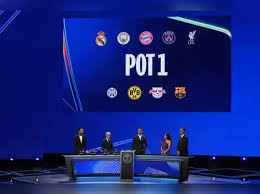
The UEFA Champions League (UCL) is arguably the most prestigious club competition in European football. Each season, the tournament draws the best teams from across the continent, uniting them in a battle for supremacy. One of the most anticipated and exciting events in this competition is the draw, which sets the stage for how teams will face off against each other throughout the tournament. The draw itself is a spectacle that generates significant buzz among players, coaches, and fans alike. In this article, we will explore the UEFA Champions League draw in depth, examining its significance, format, and implications on the competition.
The Importance of the Draw
The draw for the UEFA Champions League is not merely a formality; it is a pivotal moment in the competition. For clubs involved, the draw can have significant implications for their chances of advancing through the tournament. The draw determines the matchups for both the group stage and subsequent knockout rounds, and as such, it plays a crucial role in shaping the trajectory of the competition.
1. Setting the Stage for the Competition
The UCL draw officially kicks off the tournament by creating a sense of anticipation and excitement. For fans, it is an opportunity to find out which teams their respective clubs will face, and for the players, it is a chance to size up the competition. The draw has a way of generating a buzz, with predictions and analysis about potential matchups filling media outlets and fan discussions. There is also a certain level of drama that comes with the draw, as certain teams are considered “group of death” candidates while others may be seen as “favorable” draws.
2. Strategic Planning for Coaches and Players
Coaches and players alike approach the draw with a mix of excitement and trepidation. They know that the outcomes of the draw will impact their team’s strategy in the coming months. A tough group can mean the difference between early elimination and a successful campaign, while a more favorable group can offer a smoother path to the knockout rounds. Managers will quickly begin analyzing their potential opponents, examining past performances, playing styles, and individual player capabilities to formulate their tactics for each game.
3. Media Attention and Commercial Value
The Champions League draw generates tremendous media attention, not only because of the excitement around matchups but also because of the commercial value it brings. The UCL is one of the most-watched sporting events globally, and the drama of the draw only adds to the spectacle. Media outlets, broadcasters, and sponsors eagerly await the draw as it can impact TV ratings, merchandise sales, and overall fan engagement. Big names, historic rivalries, and unexpected surprises in the draw tend to keep audiences captivated, ensuring that the tournament remains a global event that attracts commercial interests from various sectors.
The Format of the UEFA Champions League Draw
The format of the UEFA Champions League draw is highly structured and follows a well-established process. It is divided into two main sections: the group stage draw and the knockout stage draw. Each of these stages has its own set of rules and procedures that ensure fairness and excitement.
Group Stage Draw
The first and most important draw of the UCL season is the group stage draw. This draw typically takes place in late August and marks the beginning of the tournament proper. The draw is conducted using a seeding system to ensure that the strongest teams (based on their coefficients) are spread evenly across the groups.
- Seeding System The seeding system is designed to create a fair and balanced draw, where the strongest teams do not all end up in the same group. The teams are placed into four pots, each containing eight teams. Pot 1 contains the defending champions, as well as the top-ranked teams based on UEFA coefficients. Pots 2, 3, and 4 consist of teams ranked based on their coefficients from previous performances in European competitions. The seeding system is essential in ensuring that the best teams are not pitted against each other in the early stages of the competition, creating exciting but manageable matchups in the group stage.
- The Draw Process The group stage draw is usually conducted by former football stars or UEFA officials, with a live broadcast to allow fans worldwide to follow the process. Each team is drawn from one of the pots and placed into one of the eight groups (labeled A to H). No group can contain more than one team from the same country, ensuring that the draw remains diverse and global. The group stage matches are round-robin, meaning each team will play the other teams in their group home and away, for a total of six games. The top two teams from each group advance to the knockout rounds, while the third-placed teams drop into the UEFA Europa League.
- Implications of the Group Stage Draw The group stage draw can have a massive impact on a team’s progress in the competition. Groups are often referred to as “groups of death” when they feature multiple top-tier teams, creating a highly competitive environment. Teams that are drawn into these difficult groups often have to fight tooth and nail to secure a spot in the knockout rounds, which adds an element of unpredictability to the competition. Conversely, teams drawn into relatively easier groups might feel more confident about advancing but could risk underestimating their opponents. Historically, surprise results have occurred when smaller teams have stunned their more illustrious counterparts, proving that no draw is ever truly easy.
Knockout Stage Draw
After the conclusion of the group stage, the teams that progress to the knockout rounds are placed into a new draw for the Round of 16. This draw is equally important because it sets up the high-stakes encounters that define the latter stages of the competition.
- Knockout Format In the knockout rounds, teams compete in two-legged ties, with each team playing one home game and one away game. The team with the higher aggregate score (combining goals from both legs) advances to the next round. If the aggregate score is tied after both legs, the tie is decided by away goals, extra time, or penalties, depending on the situation.
- Draw Procedure for the Knockout Rounds Unlike the group stage draw, there are no seedings in the knockout draw. The 16 teams that progress from the group stage are drawn against one another randomly. However, there are some restrictions: teams from the same country cannot be drawn against each other, and teams that were in the same group cannot meet again in the Round of 16. This ensures that the draw remains diverse and unpredictable. The knockout stage draw is often followed by intense media speculation and analysis, as fans and pundits debate which teams have the best chances of progressing through to the final.
The Drama and Anticipation of the Draw
The UEFA Champions League draw is an event that captivates football fans across the world. The buildup to the draw generates excitement, as teams and supporters await to discover their fate in the competition. The atmosphere surrounding the draw is one of suspense, as fans hope for favorable matchups while fearing the dreaded “group of death.”
The unpredictability of the draw adds to the drama of the Champions League, making it a truly unique experience for players, coaches, and fans alike. Some draws are memorable because they create epic clashes between heavyweights, while others are exciting because of the possibility of an underdog upsetting the odds. The fact that every season produces fresh matchups and new narratives ensures that the draw remains one of the most thrilling parts of the Champions League cycle.
Conclusion
The UEFA Champions League draw is more than just a procedural formality; it is a highly significant event that shapes the course of one of the most prestigious tournaments in world football. From the seeding system to the knockout rounds, the draw impacts every team’s chances and contributes to the excitement and drama of the competition. Fans, players, and coaches eagerly anticipate the moment when the groups and matchups are revealed, knowing that this will set the stage for the battles to come. Whether it’s the anticipation of facing a fellow European giant or the hope of drawing a less challenging opponent, the UEFA Champions League draw is a defining moment in the tournament’s calendar, fueling the passion and intrigue that make this competition so captivating.







